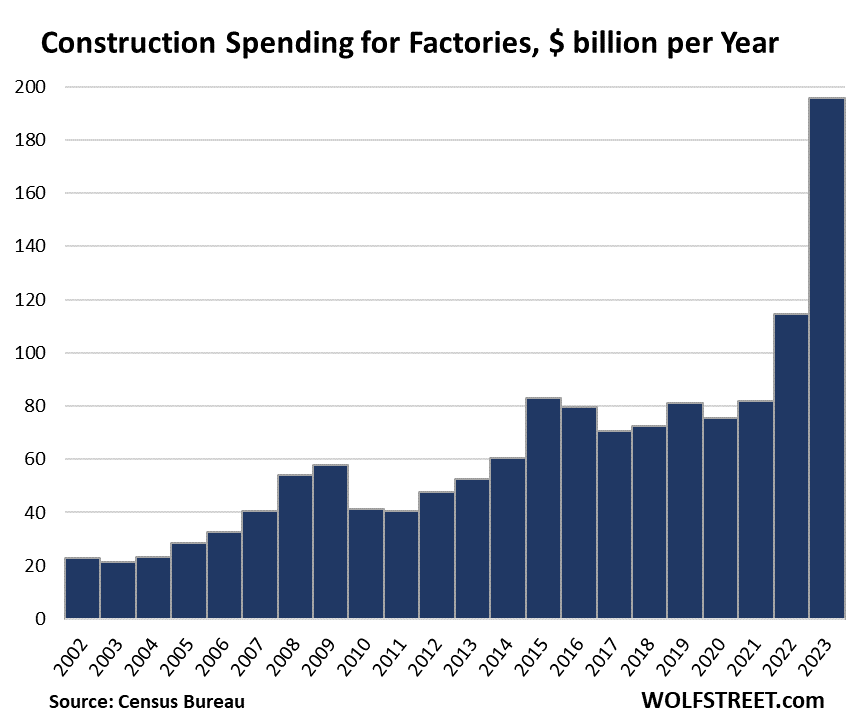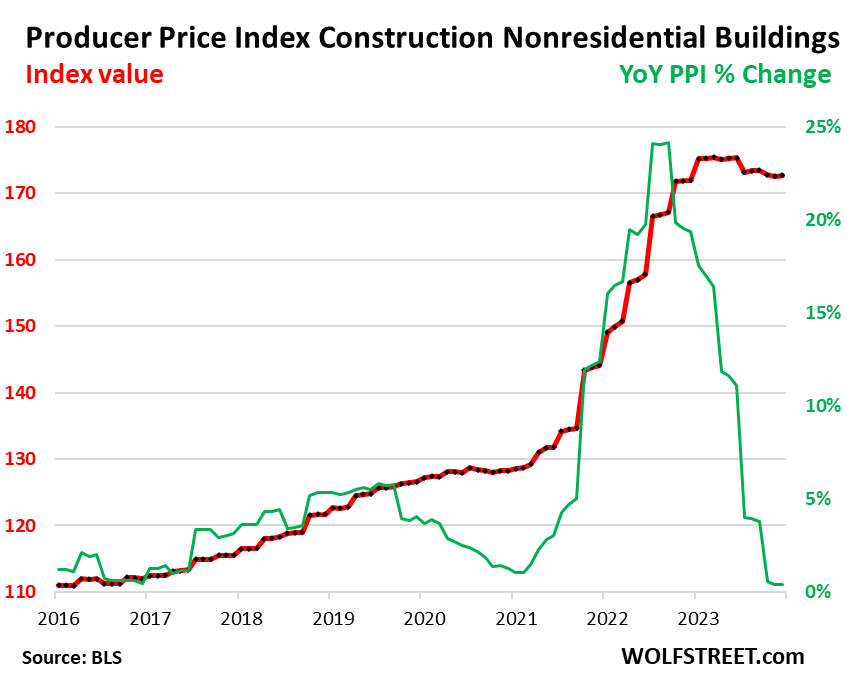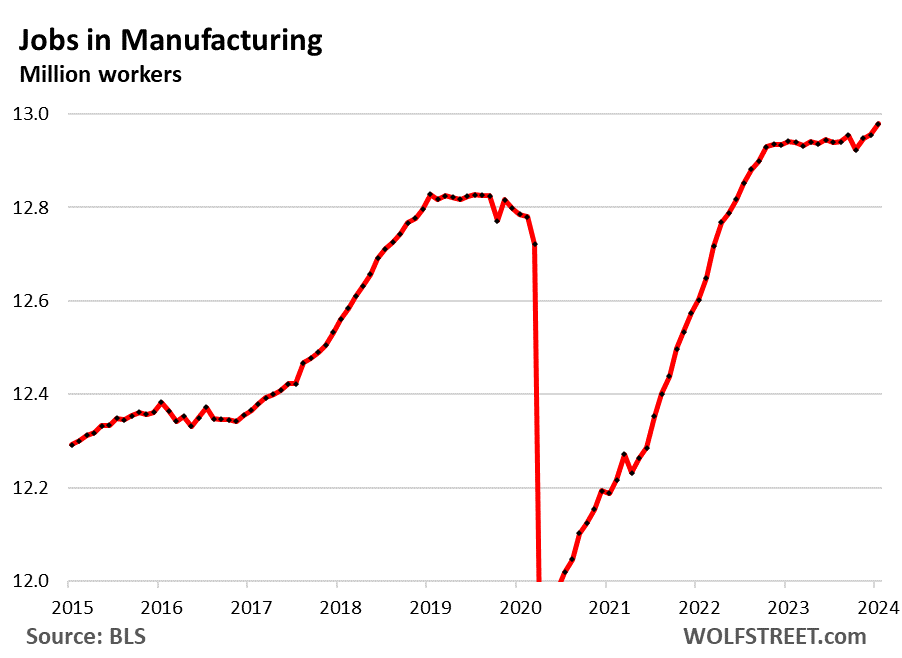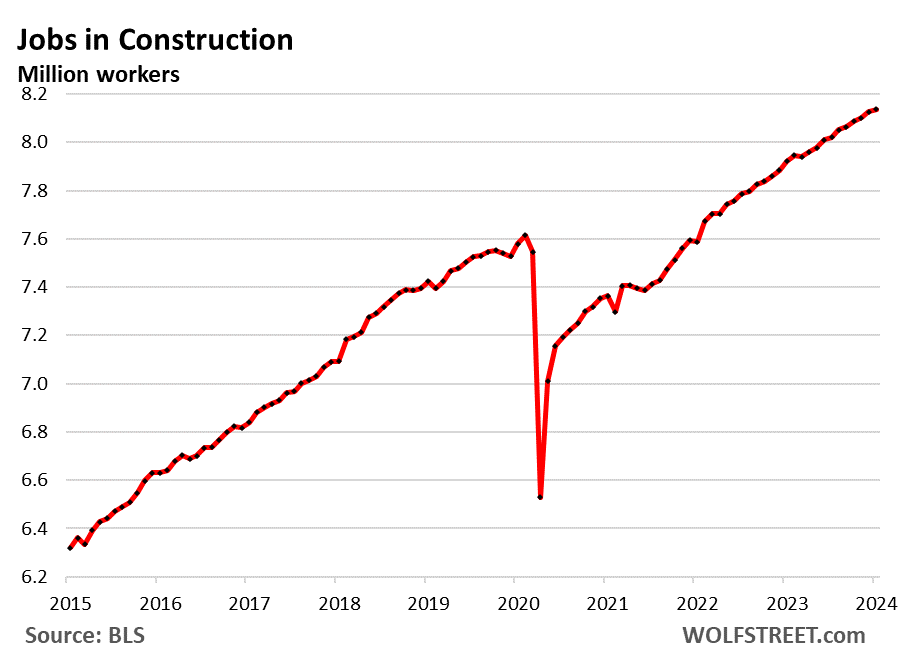Disrupted supply chains, strained U.S.-China relations and a formidable dependence on China have led to a rethink, now manifesting itself in investments in manufacturing plants.
Written by Wolf Richter of Wolf Street.
In December, companies poured $18.4 billion into building U.S. manufacturing plants ($220 billion annually), up 64% from a year ago, 131% from two years ago, and 170% from December 2019. From data from the Department of Commerce. The boom in investment in manufacturing plants began in mid-2021.
For the full year of 2023, spending on factory construction jumped 71% from 2022 and 138% from 2021 to $196 billion. It's an eye-opening boom. This is due to the supply chain and transportation disruptions that companies have encountered during the pandemic, the fragile and rocky relationship between the United States and China, the formidable dependence of U.S. companies on production in China, and, when it comes to semiconductors, the growing dependence on China. This is the result. Manufactured in Taiwan. All of this has caused companies and governments to reconsider.
Still, as we'll soon see, government subsidies for the semiconductor industry have not yet been disbursed and are not yet reflected in this data. More on that later. And the 2023 boom wasn’t construction cost inflation. Because it's almost calm.

The United States is the second largest manufacturing country after China, and its share of global production is larger than Germany, Japan, and India combined. However, it lags far behind China in manufacturing. And many U.S. companies and entire industries are heavily dependent on China, and they were given a wake-up call during the 2020-2021 shortages and supply chain disruptions.
$53 Billion CHIPS Act: Funds have not yet been disbursed, but will continue to be disbursed.
The CHIPS Act, passed in 2022, is a package of subsidies, loans, loan guarantees and tax credits to attract semiconductor manufacturers to onshore semiconductor production. Of the $53 billion, $39 billion is manufacturing subsidies, covering up to 15% of a factory's total costs (up to $3 billion per factory).
Approximately 80% of a fab's cost is equipment. Construction costs are only a small part of the total. Regarding the data here, we only look at spending on factory construction, not equipment.
However, the process of project approval and cash disbursement was slow. More than 170 companies have applied, including major companies such as Intel, Taiwan Semiconductor Manufacturing Co. (TSMC), Samsung, and Texas Instruments. However, no funding has been disbursed yet other than two small grants, according to the Journal.
A Commerce Department spokesperson told the Journal: “This is a merit-based process that involves intense trade negotiations. CHIPS awards are entirely dependent on which projects advance America's economy and national security.” Told.
Industry executives familiar with the negotiations told the Journal that large subsidy announcements are expected in the coming months. The announcement is preliminary and will be followed by due diligence and a final agreement. Funding will be disbursed in stages as the project progresses. But the plant could still take years to complete due to permitting issues and other delays.
Among the complexities and delays are national security CHIPS Act requirements, a potential skilled labor shortage given this sudden boom in activity, and large-scale federal funding before grants can be awarded. It includes the National Environmental Policy Act, which requires projects to pass an environmental review. According to the WSJ, it could take years.
So these government funds are future and have not yet trickled into the factory construction spending data here.
However, corporate investment is pouring in, and semiconductor manufacturers are already working on large-scale projects. Intel is building factories in multiple states with a total investment of more than $43 billion. TSMC is building two factories near Phoenix, with a total investment of $40 billion. Samsung Electronics is investing $17 billion in a factory near Austin. Texas Instruments is investing $30 billion in a major project near Sherman, Texas. etc.
These are the total project costs including equipment. Construction costs alone are only a fraction of the cost. But it adds up.
All of this activity is occurring before any government funds are spent and before any government funds are reflected in the data here on factory construction.
Construction cost inflation was not behind the 2023 price hike.
The producer price index for non-residential building construction peaked in January 2023 and has since declined by 1.4%, remaining roughly flat year-on-year. Therefore, construction cost inflation was not a major factor in the surge in construction spending in 2023, although it was a factor in 2022.

Investing in manufacturing plants has a massive long-term impact on the economy.
Construction expenditures are one-time activities to develop buildings and infrastructure. Next is purchasing and installing the equipment. Modern plants are highly automated. And equipment is more expensive than buildings. The actual production takes place over many years and has secondary and tertiary effects on local and national economies.
Automation equipment and industrial robots cost about the same in the United States and China. Labor costs in the U.S. are much higher, but bringing manufacturing domestically reduces other costs. Transportation costs are lower, lead times are shorter, geopolitical uncertainty is reduced, and technology transfer reduces the risk of losing or abandoning intellectual property. Somewhere during the pandemic, something seemed to click in the corporate mindset.
Also note that manufacturing employment rose to a 15-year high.
Manufacturing employment rose to 13 million in January, the highest level in 15 years, according to Friday's jobs report.

And construction employment has increased to an all-time high.:
Friday's jobs report showed manufacturing employment rose to 8.1 million in January, a record high.

Enjoy reading and supporting Wolf Street? You can donate. I appreciate it very much. Click on the beer and iced tea mugs to see how:

Would you like to receive email notifications when new articles are published on WOLFSTREET? Sign up here.
![]()

